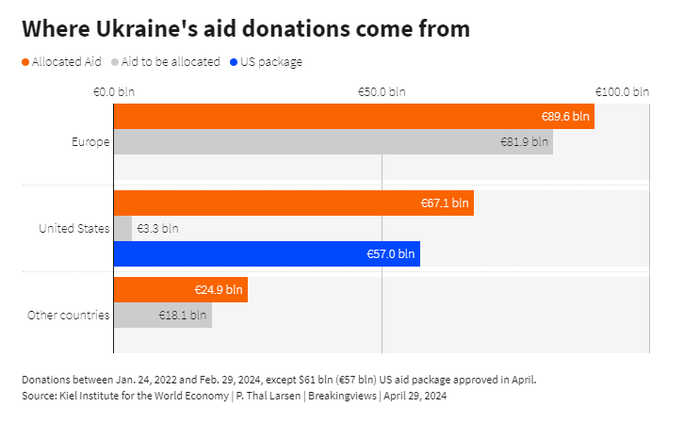Published 19:56 IST, April 30th 2024
Ukraine’s $61 bln lifeline is not enough
Russian President Vladimir Putin’s calculations might also change if he thought Ukraine could hold on for many more years.
- Republic Business
- 5 min read

Billion-dollar maybe. Ukraine last week got a vital $61 billion lifeline from the United States. But it still needs a medium-term funding plan to withstand Russia’s onslaught. Mobilising Moscow’s frozen central bank assets to provide compensation for war damages should be central to this.
Combined with commitments from other countries the latest U.S. package – which will mostly provide Ukraine with weapons and train its troops – should see Kyiv through to about the end of next year. That is certainly better than the situation the country faced a week ago, when it was running dangerously low on military supplies with which to defend itself.
But Ukraine could run out of weapons again in late 2025. Even if Joe Biden is re-elected as U.S. president this November, he may struggle to get more money out of Congress. And if Donald Trump returns to the White House, American support for Ukraine will be even more precarious given the Republican candidate’s previous lack of commitment to Kyiv’s defence.
A multi-year funding plan, by contrast, would have several benefits. For a start, it would provide some insurance against U.S. political swings. It would also boost Ukrainian morale and give Western arms manufacturers greater confidence to ramp up production.
Russian President Vladimir Putin’s calculations might also change if he thought Ukraine could hold on for many more years. Ukrainian President Volodymyr Zelenskiy probably wouldn’t be able to retake much territory because that would mean attacking Russia’s heavily defended positions at a time when Ukraine is finding it hard to recruit new soldiers. But he might be able to negotiate a peace deal from a stronger position – or freeze the conflict, a bit like North and South Korea suspended their war 71 years ago.
How the maths stacks up
Ukraine is straining every sinew to hold the line against Russia, an adversary whose $2 trillion economy was 11 times bigger than its own last year. Even though it spent $65 billion on defence in 2023 – an astonishing 37% of its economic output – that was dwarfed by Russia’s $109 billion outlay, according to the Stockholm International Peace Research Institute (SIPRI).
Western aid plugged the gap. The United States and Europe allocated 88 billion euros in aid to Kyiv last year, of which 47 billion euros was military support and the rest was financial and humanitarian aid, the Kiel Institute for the World Economy calculates. Allocations – support delivered or earmarked for delivery – are a proxy for money that was disbursed.

Longer runway
The main way to get much more money to Ukraine is to mobilise Russian assets that Western countries froze at the start of the war, worth about $320 billion. Ideas include confiscating the assets, using them to support a loan that Western countries would give Ukraine, or handing Kyiv the interest they generate.
The United States is pushing a plan to raise money for Kyiv by capitalising interest payments building up at Euroclear, the clearing house in Belgium where most of the assets are held. A special-purpose vehicle would probably issue a bond backed by future interest rates and pay the proceeds to Ukraine. The United States hopes to persuade its partners in the Group of Seven rich democracies to back this idea at their summit in June. If the countries guaranteed interest from the assets for a decade, they might raise 30 to 40 billion euros.
While this will help, it will not be a game changer because it will fund Ukraine for less than half a year. Getting Kyiv $320 billion, however, would be a different proposition. That would finance the war until at least the end of 2028. If the belligerents ended or froze the conflict before then, Ukraine could use some of the money to rebuild its economy, which the World Bank estimates will cost $486 billion.
Although Biden now has the authority to seize Russian funds, only about $5 billion of the assets are in the United States. The bulk are in European Union countries, which have legal qualms about confiscating them.
A more realistic alternative, therefore, is a syndicated reparation loan – a scheme I developed with Lee Buchheit, a veteran legal expert in sovereign debt, and Daleep Singh, who wrote in a personal capacity before he became the U.S. Deputy National Security Advisor for International Economics in February.
In a nutshell, Ukraine would pledge its claim for reparations against Russia to a syndicate of its allies in return for a loan. If Moscow refused to pay the damages, the allies could use Russia’s frozen assets to pay off the loan. This is legally more robust than confiscation.
As the G7 moves ahead with capitalising the future interest on Russia’s assets, it should make clear that this in no way prejudges a much bigger funding package later. It can also make progress on the reparation loan by accelerating the creation of an international compensation commission with the authority to award damages.
The United Nations General Assembly has already said such a body is needed and the Netherlands agreed in principle earlier this month to host it. Once Ukraine’s allies know it will be set up, they will be more willing to participate in the reparation loan.
Western countries may relax now that the U.S. Congress has finally agreed $61 billion in aid. This would be a mistake. Ukraine’s allies need to build on last week’s good news to extend a more ambitious lifeline.
Updated 19:56 IST, April 30th 2024